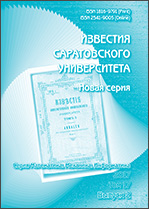|
Mechanics
Gasdynamics and magnetohydrodynamics of the interplanetary and interstellar gas interaction. Theory and experiments
V. B. Baranovab
a M. V. Lomonosov Moscow State University
b A. Ishlinsky Institite for Problems in Mechanics, Russian Academy of Sciences
Abstract:
A problem of the interaction between interplanetary and interstellar gas flows is the problem of the interaction between the supersonic flow of the fully ionized hydrogen gas flow from a source (solar wind) and the supersonic translational flow of the interstellar gas which has neutral ($H$ atoms) and plasma (electrons and protons) components. Self-consistent, kinetic-continual model of this interaction, suggested in [8], is described in this paper. This model has the basic peculiarity connected with the mean free path of $H$ atoms in a main process of the resonance charge exchange (charge exchange between $H$ atoms and protons), namely, Knudsen number in this process $Kn\sim1$, i. e. hydrodynamic equations are not correct for describing $H$
atoms motion. Euler equations with “sources” of the momentum and energy for the plasma component and the Boltzmann equation for neutral component are solved in the model [8]. Mathematical formulation of the problem considered and the basic results of numerical calculations are in details described. Some predictions of the model [8] were later confirmed by experimental data obtained onboard of spacecraft investigating outer regions of the solar system. For example, the “hydrogen wall”, predicted in [7, 8], was discovered
experimentally onboard of Hubble Space Telescope [11] and Voyagers 1 and 2 have crossed the solar wind termination shock in December 2004 (at the distance 94 AU) and in August 2007 (at the distance 84AU) respectively (see Fig. 2) and so on. Results of a development of the model in [8] taking into account effects of the solar cycles, anomalous cosmic rays, interstellar magnetic field and so on are also described.
Citation:
V. B. Baranov, “Gasdynamics and magnetohydrodynamics of the interplanetary and interstellar gas interaction. Theory and experiments”, Izv. Saratov Univ. Math. Mech. Inform., 8:3 (2008), 18–25
Linking options:
https://www.mathnet.ru/eng/isu116 https://www.mathnet.ru/eng/isu/v8/i3/p18
|

| Statistics & downloads: |
| Abstract page: | 349 | | Full-text PDF : | 218 | | References: | 46 | | First page: | 1 |
|




 Contact us:
Contact us: Terms of Use
Terms of Use
 Registration to the website
Registration to the website Logotypes
Logotypes








 Citation in format
Citation in format 